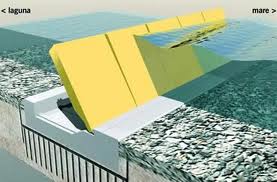Disagreements over whether sea level rises would make Venice’s mobile dams unworkable
On 10 December 2012, the Venice branch of conservationist organization Italia Nostra issued a press release arguing that rising sea levels will make Venice’s mobile dams unworkable: Mose_Pirazzoli_comunicato1
This claim was based on statements made by Paolo Antonio Pirazzoli during a conference presentation on 28 September 2012. Pirazzoli suggested that the design of the dams did not take sufficient sea level rises into account, especially the projections by the Intergovernmental Panel on Climate Change (IPCC) of a 50-140 cm rise by 2100. Pirazzoli added that resonance between the dams will mean they will not be able to protect the city. His presentation in English can be viewed at this website by clicking on this link:
Will the MoSE project be able to defend Venice against the predicted sea-level rise?
Pirazzoli also criticised the dam project for not being reversible, yet finished this presentation by advocating “a permanent water-tight dyke separating the lagoon from the sea.”
The dam project is currently 65% constructed with completion expected in 2016. The New Venice Consortium (CVN) building the dams disputes Pirazzoli’s claims, arguing that the dams will be able to cope with a sea level rise of 60 cms. The CVN’s rebuttal of Pirazzoli and Italia Nostra was reported in this article in the Venetian newspaper Il Gazzettino di Venezia on 11 December 2012:
Mose_Pirazzoli_Gazzettino
As described in my book, Venice in Environmental Peril? Myth and Reality (2012), Pirazzoli and the CVN have been making counter-claims about the dams since the early 1980s. As recommended in the book, Pirazzoli’s findings should be examined by the CVN and taken into account, especially the concerns about resonance. However, his assertions that the dams will be redundant due to sea level rises are based on projections for 2100 by the IPCC. We simply do not know what level the seas will be then and IPCC projections have frequently been revised downwards and questioned. It is possible the MOSE dams will not be able to cope with high sea level rises and might experience engineering problems. Yet we cannot reject them on the basis of projections for conditions that might exist in 88 years time. Moreover, the MOSE dams were designed as a temporary response to high tides for 100 years. If they had not been held up by opponents over the last decade, Venetians could already be benefiting from them. A different response to flooding might be necessary in the long-term, but why reject a project before observing its effectiveness on the basis of distant and unreliable projections?




